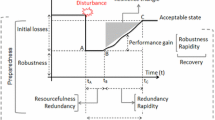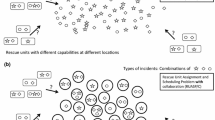Abstract
The problem of fast supply of affected cites with vital resources after a large scale disaster is under consideration. It is one of the essential components of the short-term recovery characterized by highly probable uncertainty in evaluating the state of damaged region. We propose a general principle by which the required redistribution of vital resources between the affected and neighboring cities can be efficiently implemented under such conditions. The developed principle, first, uses the triage concept determining the current city priority in the resource delivery. Second, it minimizes the delivery time subjected to this priority. Finally a certain plan of the resource redistribution is generated. A particular case when the initial communication system has crashed and formation of a new one and the resource redistribution proceed synchronously is studied numerically. The obtained results enable us to regard the resource redistribution plan governed by the proposed method as semi-optimal and rather efficient especially under uncertainty.
Access this chapter
Tax calculation will be finalised at checkout
Purchases are for personal use only
Preview
Unable to display preview. Download preview PDF.
Similar content being viewed by others
References
Comprehensive emergency management: A governor’s guide. National Governors’ Association. Center for Policy Research, Defense Civil Preparedness Agency [Department of Defense], Washington, D.C. (1979)
National Response Framework. Tech. rep., U.S. Department of Homeland Security, Washington, D.C. (January 2008)
Disaster Recovery Plan. State Of Illinois (July 2012), Attachment A: Short-term Recovery Strategy. Tech. rep., Illinois Emergency Management Agency, Illinois (2012)
National Response Framework, 2-nd edition. Tech. rep., U.S. Department of Homeland Security, Washington, D.C. (May 2013)
Afshar, A., Haghani, A.: Modeling integrated supply chain logistics in real-time large-scale disaster relief operations. Socio-Economic Planning Sciences 46(4), 327–338 (2012)
Baird, M.: The Recovery Phase of Emergency Management. Tech. rep., Intermodal Freight Transportation Institute (ITFI) University of Memphis (January 2010)
Caunhye, A., Nie, X., Pokharel, S.: Optimization models in emergency logistics: A literature review. Socio-Economic Planning Sciences 46(1), 4–13 (2012)
Haghani, A., Oh, S.C.: Formulation and solution of a multi-commodity, multi-modal network flow model for disaster relief operations. Transportation Research Part A: Policy and Practice 30(3), 231–250 (1996)
Lin, Y.H., Batta, R., Rogerson, P., Blatt, A., Flanigan, M.: A logistics model for emergency supply of critical items in the aftermath of a disaster. Socio-Economic Planning Sciences 45(4), 132–145 (2011)
Panda, R.: Japan’s Disaster Response Management: Lessons for the World. Journal of Defence Studies 6(1), 59–76 (2012)
Wikipedia: Tōhoku Earthquake and Tsunami. (2011), http://en.wikipedia.org/wiki/2011_Tohoku_earthquake_and_tsunami , http://en.wikipedia.org/wiki/2011_Tohoku_earthquake_and_tsunami (Online; modified on 2 July 2013)
Author information
Authors and Affiliations
Editor information
Editors and Affiliations
Rights and permissions
Copyright information
© 2014 Springer-Verlag Berlin Heidelberg
About this paper
Cite this paper
Lubashevskiy, V., Kanno, T., Furuta, K. (2014). Resource Redistribution after Large Scale Disasters: Case with Gradually Updated Information. In: Tanaka, S., Hasegawa, K., Xu, R., Sakamoto, N., Turner, S.J. (eds) AsiaSim 2014. AsiaSim 2014. Communications in Computer and Information Science, vol 474. Springer, Berlin, Heidelberg. https://doi.org/10.1007/978-3-662-45289-9_28
Download citation
DOI: https://doi.org/10.1007/978-3-662-45289-9_28
Publisher Name: Springer, Berlin, Heidelberg
Print ISBN: 978-3-662-45288-2
Online ISBN: 978-3-662-45289-9
eBook Packages: Computer ScienceComputer Science (R0)




